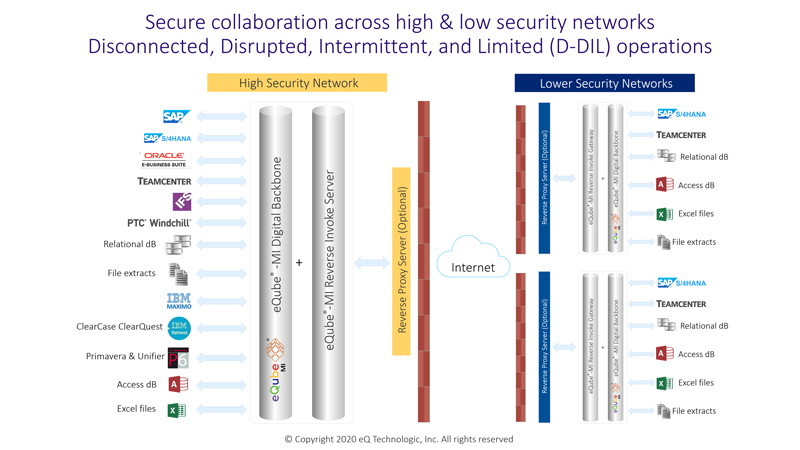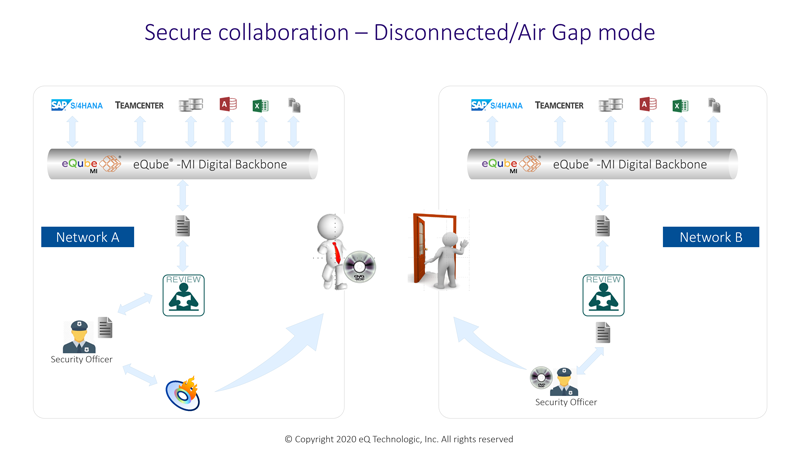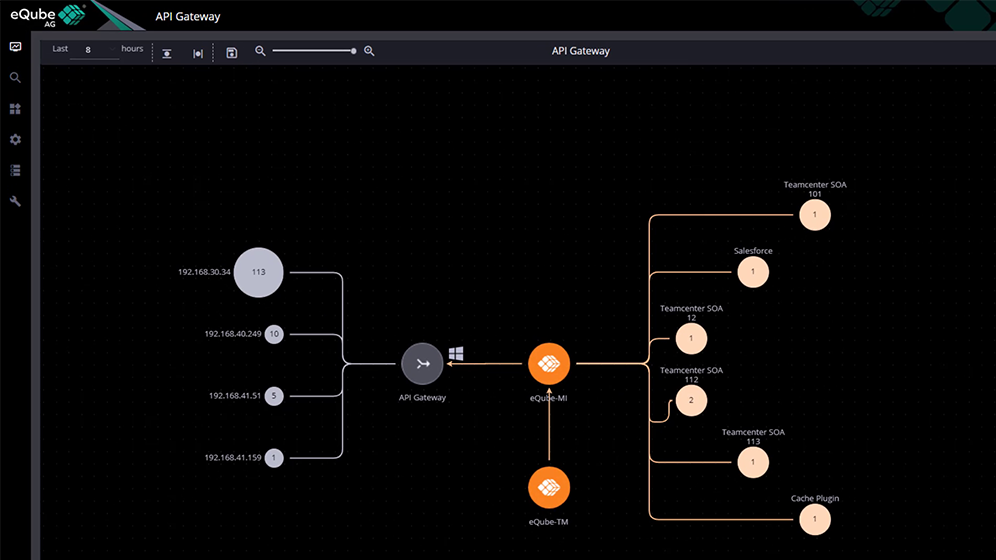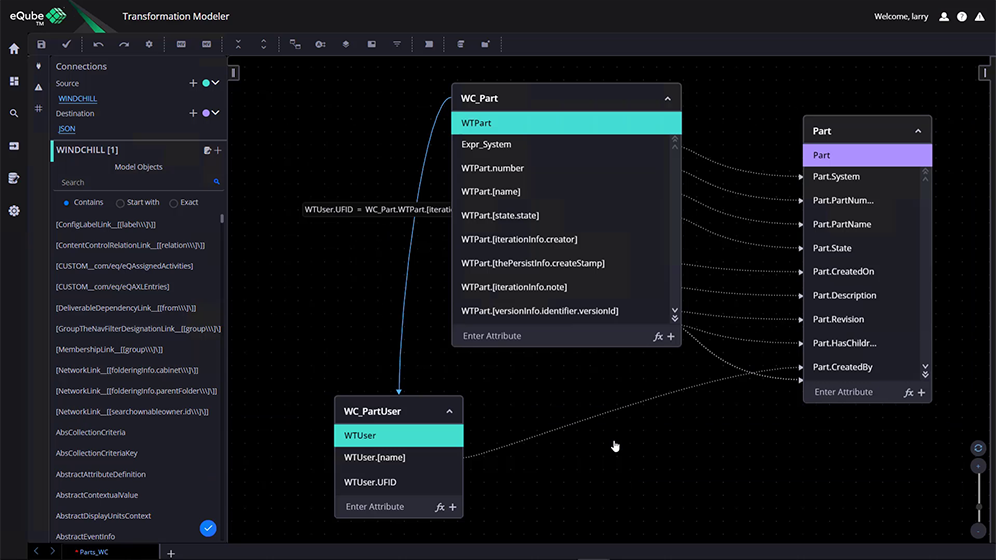eQube®-MI - The next generation hybrid integration platform
More...
A BPMN-compliant (Business Process Model and Notation) Process Designer integrated in eQube®-MI enables visual development of interfaces that include process workflows and processing pipelines containing the integration steps necessary for a given data integration pattern. With the Process Designer, all enterprise integration patterns are supported.
Processes can be nested, support transaction boundaries, and include manual steps such as approvals and other forms of human intervention. With the Process Designer, interfaces can be readily developed by visually designing processing pipelines made up of activities, gateways, effects, and paths that capture the business logic of an interface and its process orchestration.
The highly configurable eQube®-TM maps are directly consumed in the MI processing pipelines as 'activities', providing flexibility to the developers to rapidly implement APIs (REST, OData or Web services). This capability can be used to build OData or REST service layer on top of one or more Enterprise applications (legacy systems, COTS with old and new versions).
With the eQube®-DaaS Platform, 'last-mile' connectivity is addressed without any developer having to write code in the endpoints or connectors! eQube®'s Low / No-code integration environment has powerful and intuitive UI that enables modeling interfaces in the MI Process Designer as process workflows or processing pipelines with TM defined transformation maps directly consumed in steps of the processing pipelines.
The application specific eQube® Connectors working with the integrated Data Virtualization layer with semantics underpin the TM maps enabling MI to efficiently execute interfaces. Therefore, the speed and agility with which interfaces can be developed, maintained and modified is unprecedented. It supports microservices development architecture enabling development of interfaces conforming to service orchestration design. A business process modeled in eQube®-MI (either a microservice or a complex business process) can be exposed as a REST or OData or Web service API.
The entire business logic of an interface resides in the realm of eQube®-MI managed by its integrated Process Designer. The pre-built eQube® Connectors are stateless and are developed using the underlying application's published services or APIs. The integrated revolutionary eQube® Data Virtualization Layer interacts with the eQube® Connectors allowing for efficient data fetch and insert/modify operations as well as creating complex linkages between various objects in the target system.
The combination of eQube®-MI Process Designer, eQube®-TM maps and models, eQube® Data Virtualization layer, and eQube® Connectors results in no 'last-mile' coding or end-point coding. Therefore, changes to the business logic of interfaces or the impact of version changes of the source / destination applications are managed within the boundary of eQube®-MI and not in the 'last-mile' connectivity, thereby reducing rework, implementation time and lowering total cost of ownership.
Although the eQube®-MI based integration approach is different than traditional integration platform's (ESBs, message brokers, …) approach, due to eQube®'s open architecture, eQube®-MI can readily leverage prior investments made by a customer in other integration platform (s). It can exchange data with any other integration platform as SOAP or JSON or as a Web service or REST service or API. Thus eQube®-MI can easily co-exist with other integration platform (s) providing the greatest flexibility.
Less...
Secure Collaboration across networks, partners, and customers

1. Secure collaboration between higher and lower security level networks - 'connected mode':
More...

2. Secure collaboration 'disconnected mode':
Under this mode of collaboration, participating applications are not on the same network with no ability to connect across networks, essentially 'air-gapped' networks. eQube®-MI can be deployed on both networks. Using eQube®-MI, data from a source system (s) is extracted, transformed, and can be submitted to a workflow for security approval for transferring the data out of the network. Upon the security approval, the data can be written to a file and if required, the file can be encrypted with any algorithm of choice. This source system transaction file then can be physically carried over to the other network where target system is located. At the target network, using eQube®-MI it can go through a reverse process of decryption, security workflow approval for ingestion of data, and then inserting the data in the relevant target application (s). The diagram depicts this approach.3. Secure collaboration 'disconnected, disrupted, intermittent and limited connected mode' (D-DIL):
Under this mode of collaboration, source and target systems are on different networks and may not be connected at times. In this scenario, eQube®-MI can be deployed on both networks with RI deployment as discussed in section '7) a.' above. eQube®-MI deployed in a network can establish a perpetual or always-on connection with eQube®-MI deployed in the other security network (s). If there is no network connectivity for some time, then eQube®-MI with RI Server will put the transactions in eQube®-MI queue and will continue to ping to establish a connection. RI Gateway on the other server (s) will accumulate transactions in its queue (s). As soon as the network connectivity is available, all accumulated transactions will be transferred to the other eQube®-MI sever on the other network. The transactions can be encrypted and compressed for secure and efficient transfer. Diagram in first point above shows the concept.Less...
Master Data Management
eQ's recommended approach for MDM revolves on the philosophy of 'keeping data where it belongs – in the source systems' – essentially, a decentralized MDM solution. Traditional approach to MDM involves extracting relevant data from multiple systems and storing it in a centralized MDM database.
MDM database becomes the master for certain data types and changes to the master data are managed in the MDM system that are propagated to upstream and downstream systems. There are several challenges with this approach:
- Efforts, time, and costs involved in the initial setup and on-going maintenance of the data extraction, transformation, and load (ETL) infrastructure and the central MDM database.
- Efforts, time, and costs involved in adding change management functionality to the MDM system including infrastructure to propagate the changes to other systems.
Using eQube® platform the MDM challenge can be addressed in multiple ways:
- If a customer insists on using a central MDM system or has a requirement to maintain or upgrade an existing MDM system, then eQube® platform-based solution can be rapidly built to populate and maintain a central MDM system. With eQube®-MI, the initial solution development time can be substantially reduced. Additionally, when the source applications are upgraded to their respective next versions, due to the eQube® architecture, the impact of such upgrades on the solution is minimized.
- eQ's recommended approach for MDM revolves on the philosophy of 'keeping data where it belongs – in the source systems' – essentially, a decentralized MDM solution. Under this approach, the system of record (SOR) for each key data element is identified and is designated as the 'master' for that data element. All changes to each key data element are managed by change management process in each SOR for that data element. eQube®-MI based business processes are developed to propagate those changes from each SOR to appropriate downstream and upstream systems. The advantages of this decentralized approach to MDM are as follows:
- Simplified MDM solution as there is no central MDM system.
- Keeps data where it belongs. No central copies of data are created.
- Leverages core capabilities of each SOR regarding data integrity checks and change management process for each relevant data element. No need to have change management process in a central MDM system.
- eQube®-MI orchestrates the changes in upstream and downstream systems and due to use of eQube®-MI, version upgrades of SORs have minimum impact on the solution.
- All these benefits add to speed, agility, and lower total life cycle cost of a scalable MDM solution.

.png)
